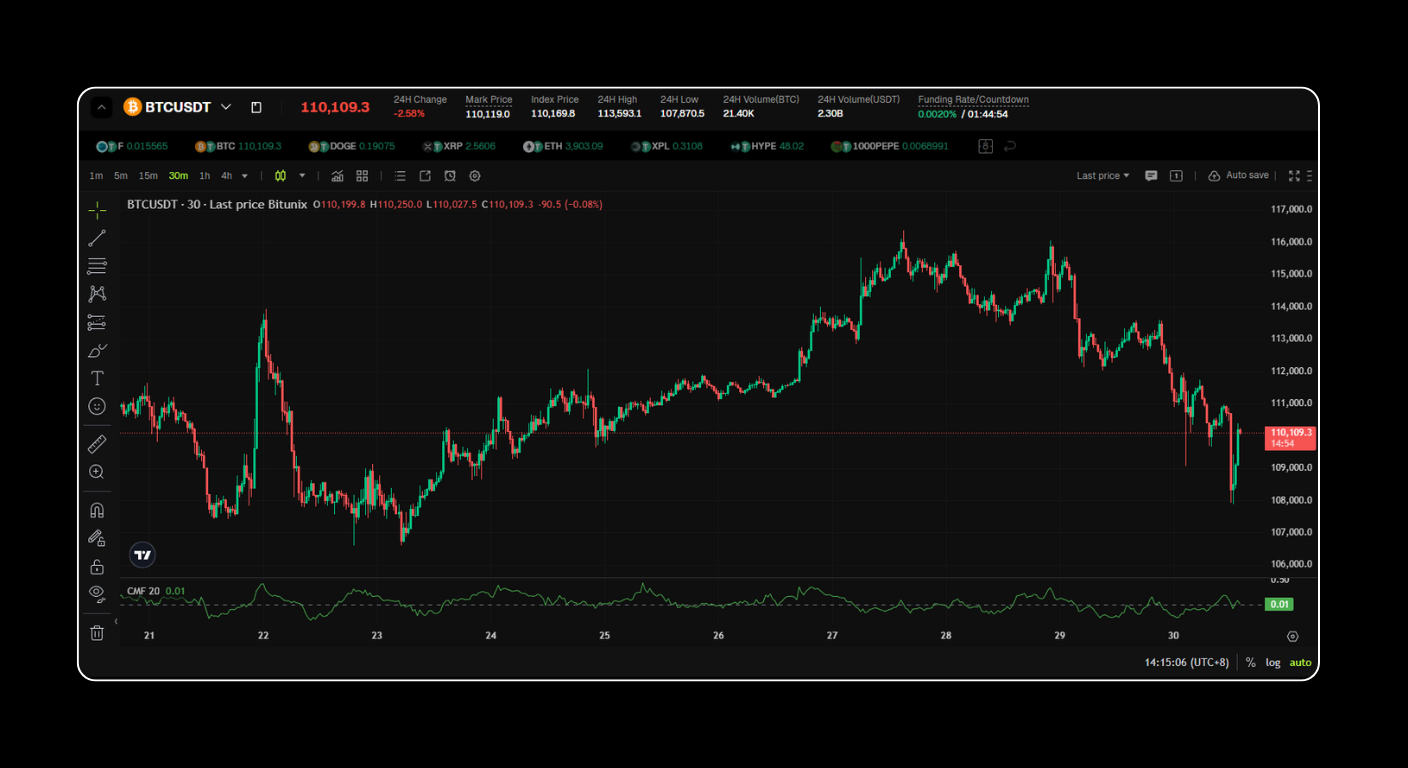
The Federal Reserve announced a 25 basis point rate cut on October 30, 2025, bringing the federal funds rate to 3.75%–4.00%. The decision was accompanied by a major policy signal: the Fed confirmed that its balance sheet reduction will end on December 1, 2025.
This meeting highlighted increasing internal divisions within the Federal Open Market Committee (FOMC). Two members dissented, one favoring a larger 50 bps cut, and another preferring no change at all. Chair Jerome Powell adopted a cautious tone during the press conference, stating that another rate cut in December is “far from certain.”
The announcement triggered sharp reactions across global markets. Stocks fell from recent highs, Treasury yields climbed, and the U.S. dollar strengthened. Meanwhile, gold dropped by more than 40 dollars per ounce, and digital assets faced renewed volatility. The Fed rate cut October 2025 thus marks a pivotal moment in the evolving balance between inflation control, liquidity management, and risk appetite.
Fed Rate Cut October 2025: What the Fed Decided
A 25 Basis Point Reduction
The October meeting concluded with a quarter-point reduction, moving the target range to 3.75%–4.00%. Policymakers cited increasing labor-market softness and a slowdown in consumer demand. Inflation remains slightly above the 2 percent target, but the Committee noted that the balance of risks has shifted toward supporting employment.
Chair Powell explained that while the cut provides a cushion for the economy, further easing is not guaranteed. The decision was influenced by mixed data, uneven job growth, and evidence that prior tightening continues to affect credit conditions.
Ending Quantitative Tightening
Perhaps more significant than the rate change itself was the Fed’s decision to end quantitative tightening (QT). Beginning December 1, 2025, the Fed will stop allowing Treasury securities to roll off its balance sheet. Instead, it will reinvest maturing securities, keeping total holdings stable.
This marks the end of a long liquidity-draining process that began in 2022. The termination of QT signals that the Fed believes further balance sheet reduction could threaten market stability. Analysts interpret this move as a turning point in liquidity conditions, one that could gradually improve dollar funding availability.
Internal Divisions and Policy Uncertainty
The vote split within the FOMC was 10-2. One dissenting member wanted a larger 50 bps cut, suggesting greater concern about economic slowdown. The other preferred to hold rates steady, arguing that inflation remains too high.
This disagreement exposes the growing tension within the Fed between inflation hawks and growth defenders. Chair Powell acknowledged the difference in views and stressed that the next moves would depend on data, particularly as the government’s partial shutdown limits the availability of fresh statistics.
Market Reaction Across Major Asset Classes
Equities, Bonds, and the Dollar
Financial markets reacted with volatility immediately following the announcement.
- Equities: The S&P 500 and Nasdaq futures dropped as investors shifted from optimism to caution. Market participants interpreted the cautious tone as a sign that the Fed may not deliver another cut in December.
- Bonds: Short-term Treasury yields rose slightly, while long-term yields moved lower, flattening the yield curve. This reflected expectations of slower growth but lingering inflation.
- Dollar: The U.S. dollar index strengthened sharply, gaining on risk aversion and safe-haven demand. A stronger dollar typically tightens global financial conditions, particularly in emerging markets.
- Gold: Prices fell by roughly 40 dollars per ounce as rising yields and a firmer dollar reduced appeal for non-yielding assets.
Liquidity Conditions
Before the meeting, the Fed had already observed signs of stress in funding markets. Usage of the Standing Repo Facility had increased, suggesting a need for short-term liquidity. The end of QT is therefore designed to prevent further tightening in these markets. Analysts expect that stable reserve levels will support money-market operations but not necessarily trigger new risk-taking immediately.
Impact of the Fed Rate Cut on Crypto Markets

Macro Transmission to Digital Assets
For the cryptocurrency market, the Fed rate cut October 2025 carries multiple implications. Crypto assets tend to behave as high-beta instruments that respond quickly to global liquidity changes. While a rate cut usually supports risk appetite, the simultaneous dollar strength and cautious Fed tone limited any immediate benefit.
Rising Treasury yields and a stronger dollar often pressure speculative assets. In crypto, this manifests through declines in funding rates and reductions in leveraged positions. The initial reaction saw Bitcoin fall below 111,000 dollars, with heavy liquidations recorded across major exchanges.
Bitunix Analyst View
Analysts from Bitunix noted that Bitcoin’s liquidation heatmap shows critical support between 109,600 and 108,000 dollars. A breakdown below that level could trigger cascading liquidations, while resistance lies near 112,300 and 116,000 dollars.
The research team emphasized that with liquidity reallocation underway and the dollar regaining strength, crypto markets could enter a period of choppy consolidation. Traders should expect volatility spikes around key macro data and remain attentive to shifts in safe-haven flows.
Technical and Derivatives Perspective
Key Support and Resistance Levels
- Support: 109,600–108,000
- Primary Resistance: 112,300
- Secondary Resistance: 116,000
If the lower support breaks, forced selling could accelerate. Conversely, a sustained move above resistance would signal recovery and renewed risk appetite.
Leverage and Funding Dynamics
Data from derivatives exchanges show that funding rates turned neutral to slightly negative after the rate decision. Open interest declined by over 10 percent within 24 hours, reflecting widespread deleveraging. Historically, this kind of flush sets the stage for stabilization once excess leverage clears.
Sentiment indicators such as the Crypto Fear and Greed Index moved from neutral to “extreme fear,” consistent with temporary market stress. Historically, these sentiment collapses have preceded short-term rebounds.
Macro-Financial Context Beyond Crypto
Inflation and Growth Outlook
The Fed’s actions suggest concern about slower economic momentum. Manufacturing and consumer spending have softened, while labor-market growth shows early signs of fatigue. Inflation remains above target but is trending lower compared to early 2025.
The central bank now faces a balancing act: too much easing could reignite inflation, while too little could deepen the slowdown. The end of QT reduces the risk of liquidity accidents but may not immediately stimulate credit growth.
Global Spillovers
Global markets have reacted with caution. European and Asian equity futures traded lower after the announcement. Commodity-linked currencies, including the Australian dollar and Malaysian ringgit, weakened against the U.S. dollar. These movements indicate the global ripple effect of the Fed’s decision on capital flows and risk sentiment.
Scenario Analysis for Bitcoin and Crypto
| Scenario | Description | Crypto Market Implication |
|---|---|---|
| 1. Reflexive Rebound | Bitcoin holds above 108,000 and funding turns positive | Price may rebound toward 113,000–116,000 as shorts cover and liquidity stabilizes. |
| 2. Deeper Correction | Support fails and dollar continues to strengthen | A test of 104,000 or lower is possible with increased volatility. |
| 3. Range Continuation | Support holds and macro remains uncertain | Bitcoin consolidates between 108,000 and 112,000, with traders relying on short-term strategies. |
This structured outlook allows investors to align positioning with market behavior instead of relying on a single directional bias.
Strategic Takeaways for Investors
Maintain Risk Controls
Investors should avoid excessive leverage during periods of policy uncertainty. Stop-loss orders and disciplined position sizing are essential. Holding part of the portfolio in stable assets can provide flexibility when volatility spikes.
Monitor Key Macro Indicators
Crypto investors must now track traditional macro indicators such as:
- U.S. Treasury yield movements
- Dollar index strength (DXY)
- Repo facility usage and funding spreads
- FOMC speeches and updated projections
Focus on Structural Awareness
The environment following the Fed rate cut October 2025 is defined by neutral liquidity rather than abundant easing. Market participants should prioritize structural understanding over speculative optimism. Short-term traders may favor range trading, while long-term investors can use volatility to accumulate quality positions at lower valuations.
Broader Lessons from the Fed Rate Cut October 2025
This event illustrates the interconnected nature of global finance. The crypto market’s sharp response to a traditional policy shift confirms that digital assets are now fully integrated within the macroeconomic ecosystem.
It also reinforces that liquidity is a dominant driver of speculative performance. When liquidity expands, risk assets flourish. When it tightens, leverage becomes dangerous. The Fed’s cautious tone means that the next few months will likely bring alternating waves of optimism and correction rather than a sustained trend.
For the Fed itself, the challenge is credibility. Internal divisions create uncertainty about future policy direction. A divided FOMC can make markets more volatile as traders react to every speech and data point.
Conclusion
The Fed rate cut October 2025 is not just a routine adjustment. It represents a significant shift in how the Federal Reserve approaches liquidity and economic risk. The 25 bps reduction and the end of quantitative tightening together signal a pause in monetary contraction, but the tone of caution means volatility will remain high.
For the crypto market, this environment demands vigilance. Support at 109,600–108,000 remains the key threshold. A breakdown could trigger deeper liquidation, while a rebound above 112,300–116,000 would mark renewed stability.
Investors should focus on discipline, liquidity management, and macro awareness. The next phase of the market will reward patience rather than aggression. As the Fed’s internal divisions play out and global markets adjust, the relationship between policy, liquidity, and digital assets will continue to define the investment landscape of late 2025.
About Bitunix
Bitunix is a global cryptocurrency derivatives exchange trusted by over 3 million users across more than 100 countries. At Bitunix, we are committed to providing a transparent, compliant, and secure trading environment for every user. Our platform features a fast registration process and a user-friendly verification system supported by mandatory KYC to ensure safety and compliance. With global standards of protection through Proof of Reserves (POR) and the Bitunix Care Fund, we prioritize user trust and fund security. The K-Line Ultra chart system delivers a seamless trading experience for both beginners and advanced traders, while leverage of up to 125x and deep liquidity make Bitunix one of the most dynamic platforms in the market.
Bitunix Global Accounts
X | Telegram Announcements | Telegram Global | CoinMarketCap | Instagram | Facebook | LinkedIn | Reddit | Medium
Disclaimer: Trading digital assets involves risk and may result in the loss of capital. Always do your own research. Terms, conditions, and regional restrictions may apply.









